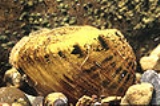
Epioblasma triquetra
Encyclopedia
Epioblasma triquetra, common name
the Snuffbox, is a species
of freshwater mussel, an aquatic
bivalve mollusk in the family Unionidae
, the river mussels. It is a rare species and currently a candidate for listing under the Endangered Species Act
.
, due to it being able to survive this violent encounter.
system and Mississippi River
system. It was classified as endangered by COSEWIC. The Canadian Species at Risk Act
listed it in the List of Wildlife Species at Risk as being endangered in Canada.
Common name
A common name of a taxon or organism is a name in general use within a community; it is often contrasted with the scientific name for the same organism...
the Snuffbox, is a species
Species
In biology, a species is one of the basic units of biological classification and a taxonomic rank. A species is often defined as a group of organisms capable of interbreeding and producing fertile offspring. While in many cases this definition is adequate, more precise or differing measures are...
of freshwater mussel, an aquatic
Aquatic animal
An aquatic animal is an animal, either vertebrate or invertebrate, which lives in water for most or all of its life. It may breathe air or extract its oxygen from that dissolved in water through specialised organs called gills, or directly through its skin. Natural environments and the animals that...
bivalve mollusk in the family Unionidae
Unionidae
Unionidae is a family of freshwater mussels, the largest in the order Unionoida, the bivalve mollusks sometimes known as river mussels, naiads, or simply as unionids.The range of distribution for this family is world-wide...
, the river mussels. It is a rare species and currently a candidate for listing under the Endangered Species Act
Endangered Species Act
The Endangered Species Act of 1973 is one of the dozens of United States environmental laws passed in the 1970s. Signed into law by President Richard Nixon on December 28, 1973, it was designed to protect critically imperiled species from extinction as a "consequence of economic growth and...
.
Reproduction
All Unionidae are known to use the gills, fins, or skin of a host fish for nutrients during the larval glochidia stage. In 2004, it was discovered that female Epioblasma triquetra mussels lure the unsuspecting fish towards them, then quickly clamp onto the head of the host fish and pump the glochidia larvae into their gills. The primary confirmed host fish for Epioblasma triquetra was found to be the common logperchPercina caprodes
Percina caprodes, the logperch or common logperch, is a fish species of the family Percidae. Like other logperches, it has the typical vertical barring along the flank and a subterminal mouth....
, due to it being able to survive this violent encounter.
Distribution and conservation status
This species lives the Great LakesGreat Lakes
The Great Lakes are a collection of freshwater lakes located in northeastern North America, on the Canada – United States border. Consisting of Lakes Superior, Michigan, Huron, Erie, and Ontario, they form the largest group of freshwater lakes on Earth by total surface, coming in second by volume...
system and Mississippi River
Mississippi River
The Mississippi River is the largest river system in North America. Flowing entirely in the United States, this river rises in western Minnesota and meanders slowly southwards for to the Mississippi River Delta at the Gulf of Mexico. With its many tributaries, the Mississippi's watershed drains...
system. It was classified as endangered by COSEWIC. The Canadian Species at Risk Act
Species at Risk Act
The Species at Risk Act is a piece of Canadian federal legislation which became law in Canada on December 12, 2002. It is designed to meet one of Canada's key commitments under the International Convention on Biological Diversity. The goal of the Act is to protect endangered or threatened...
listed it in the List of Wildlife Species at Risk as being endangered in Canada.

